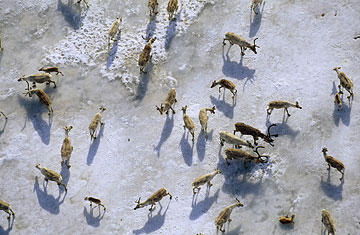
A caribou herd on the tundra
March 24, Prince William Sound, Alaska, U.S.
Mandy Lindberg kneels down on the stony beach on Knight Island, in Alaska's Prince William Sound, and begins digging. The land around her is some of the most beautiful in the U.S. Snow-capped mountains, their flanks lush with hemlock and spruce, thrust out of the glacier-fed waters of the sound. Pale Arctic terns and endangered Kittlitz's Murrelets skim the etched shoreline. To the northwest, fishing boats are setting out their gill nets, readying for the sockeye salmon's run. But as she turns her shovel on the beach, Lindberg uncovers a scar on the sound's seemingly pristine face: a pool of watery crude oil, chemical sheen glistening, fills in the hole. Search elsewhere on the beach, and on other islands in the sound, and you'll find more, just beneath the surface. The oil is the last remnant of the crude spilled on March 24, 1989, by a tanker named Exxon Valdez that ran aground just after midnight while on its way out to sea with 53 million gallons (200 million liters) of Alaskan oil on board; according to scientists from the National Oceanic and Atmospheric Administration (NOAA), about 20,000 gallons (76,000 liters) still remain buried on beaches around the sound. "At the initial time of the cleanup, we really thought this would be a one-shot deal," says Jeep Rice, the NOAA scientist who led the study, as he stands on the beach, which was nicknamed Death Marsh during the cleanup. "We had no idea there would be lingering oil."
Then again, a lot of oil — and a lot of printer's ink — was spilled because of the accident. The Exxon Valdez was at the time considered to be the worst man-made environmental disaster in U.S. history, and news of it reverberated around the world. America's last true wilderness had been violated. At least 11 million gallons (42 million liters) of crude bled into the water when the tanker struck Bligh Reef near the port town of Valdez, the terminus of the Trans-Alaska Pipeline. For months after the grounding, large swaths of the sound and its islands were coated with a foul layer of crude. Hundreds of thousands of shorebirds were killed within weeks; a productive fishing industry was damaged for years. Americans were horrified by images of oil-covered sea otters and other wildlife. A New York judge compared the spill to Hiroshima; the captain of the Exxon Valdez, Joseph Hazelwood, who was not in the wheelhouse at the time of the accident, was tried on felony charges (he ultimately was convicted of a misdemeanor and fined $50,000). "It was a bad, bad time," says Stan Stephens, a veteran tour-boat operator in Valdez. "People can't even talk about it without getting emotional."
Yet as shocking as the accident was, especially for Alaskans whose livelihoods suffered, its long-term impact on the U.S. more than two decades later can seem all but invisible, like those last pockets of oil trapped beneath the beach. Although the Oil Pollution Act of 1990 passed in the accident's immediate wake led to local improvements in shipping crude — like a mandatory shift to double-hulled tankers — spills still occur in the U.S., most recently in a 2007 accident in the San Francisco Bay that released 58,000 gallons (220,000 liters) of crude. While the partial meltdown at the Three Mile Island power plant in 1979 halted the nuclear industry in the U.S., the Prince William Sound disaster did nothing to break America's reliance on oil. Americans today are consuming 2 million more barrels of oil a day than they did in 1989. "I was hoping for a huge shift in philosophy afterwards," says Riki Ott, a biologist and fisherman from the sound who wrote a 2008 book on the spill entitled Not One Drop. "But it hasn't worked that way yet."
The notion that Alaska was unspoiled until the Exxon Valdez accident never fit with reality, though. Vast tracts of America's Arctic northwest are sparsely populated wilderness, true, but the state has been a petroleum producer since crude was discovered in south-central Alaska's Kenai Peninsula in 1957. Today, Alaska disgorges 5 million barrels of oil a day, second only to Texas in the U.S., and the Prudhoe Bay field on the state's North Slope — the source of the crude spilled by the Exxon Valdez — is the biggest in the country. Alaska is almost as much a petro-state as Saudi Arabia or Kuwait. Taxes and other proceeds from oil and natural-gas production generate 84% of government revenues. "In many ways, Alaska is oil," says state lawmaker Bryce Edgmon.
But Alaska is also the "last frontier," and this leaves many of the state's residents conflicted: they revel in the wealth oil brings, but fear its environmental toll. It's a conflict that in many ways mirrors the world's current dependence on petroleum at a time when the burning of fossil fuels is putting the planet on a path to catastrophe. Indeed, Alaska is becoming a test case to determine how people choose between oil-driven prosperity and environmental health. The clock is ticking: the giant reservoir of crude beneath Prudhoe Bay is quickly being pumped dry. Alaska's oil production has declined 38% over the past decade, and there are concerns that the Trans-Alaska Pipeline, which now carries half as much oil as it did at its peak, might not be viable in the near future unless new supplies are brought online.